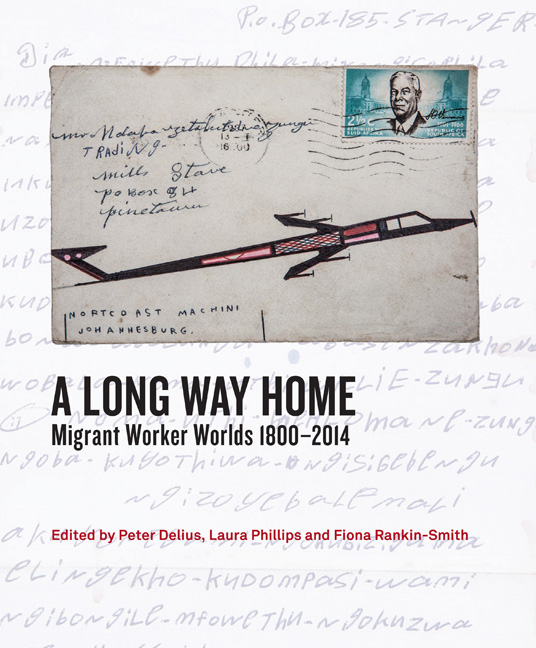Book contents
- Frontmatter
- Contents
- Acknowledgements
- Introduction: Highlighting Migrant Humanity
- Chapter 1 Ngezinyawo - Migrant Journeys
- Chapter 2 Slavery, Indenture and Migrant Labour: Maritime Immigration from Mozambique to the Cape, c.1780–1880
- Chapter 3 Walking 2 000 Kilometres to Work and Back: The Wandering Bassuto by Carl Richter
- Chapter 4 A Century of Migrancy from Mpondoland
- Chapter 5 The Migrant Kings of Zululand
- Chapter 6 The Art of Those Left Behind: Women, Beadwork and Bodies
- Chapter 7 The Illusion of Safety: Migrant Labour and Occupational Disease on South Africa's Gold Mines
- Chapter 8 ‘The Chinese Experiment’: Images from the Expansion of South Africas ‘Labour Empire’
- Chapter 9 ‘Stray Boys’: The Kruger National Park and Migrant Labour
- Chapter 10 Surviving Drought: Migrancy and the Homestead Economy
- Chapter 11 Migrants from Zebediela and Shifting Identities on the Rand, 1930s–1970s
- Chapter 12 Verwoerd's Oxen: Performing Labour Migrancy in Southern Africa
- Chapter 13 ‘Give My Regards to Everyone at Home Including Those I No Longer Remember’: The Journey of Tito Zungu's Envelopes
- Chapter 14 Sophie and the City: Womanhood, Labour and Migrancy
- Chapter 15 Bungityala
- Chapter 16 Migrants: Vanguard of the Worker's Struggles?
- Chapter 17 Debt or Savings? Of Migrants, Mines and Money
- Chapter 18 Post-Apartheid Migrancy and the Life of a Pondo Mineworker
- Notes on Contributors
- List of Figures and Tables
- Index
Chapter 9 - ‘Stray Boys’: The Kruger National Park and Migrant Labour
Published online by Cambridge University Press: 04 July 2018
- Frontmatter
- Contents
- Acknowledgements
- Introduction: Highlighting Migrant Humanity
- Chapter 1 Ngezinyawo - Migrant Journeys
- Chapter 2 Slavery, Indenture and Migrant Labour: Maritime Immigration from Mozambique to the Cape, c.1780–1880
- Chapter 3 Walking 2 000 Kilometres to Work and Back: The Wandering Bassuto by Carl Richter
- Chapter 4 A Century of Migrancy from Mpondoland
- Chapter 5 The Migrant Kings of Zululand
- Chapter 6 The Art of Those Left Behind: Women, Beadwork and Bodies
- Chapter 7 The Illusion of Safety: Migrant Labour and Occupational Disease on South Africa's Gold Mines
- Chapter 8 ‘The Chinese Experiment’: Images from the Expansion of South Africas ‘Labour Empire’
- Chapter 9 ‘Stray Boys’: The Kruger National Park and Migrant Labour
- Chapter 10 Surviving Drought: Migrancy and the Homestead Economy
- Chapter 11 Migrants from Zebediela and Shifting Identities on the Rand, 1930s–1970s
- Chapter 12 Verwoerd's Oxen: Performing Labour Migrancy in Southern Africa
- Chapter 13 ‘Give My Regards to Everyone at Home Including Those I No Longer Remember’: The Journey of Tito Zungu's Envelopes
- Chapter 14 Sophie and the City: Womanhood, Labour and Migrancy
- Chapter 15 Bungityala
- Chapter 16 Migrants: Vanguard of the Worker's Struggles?
- Chapter 17 Debt or Savings? Of Migrants, Mines and Money
- Chapter 18 Post-Apartheid Migrancy and the Life of a Pondo Mineworker
- Notes on Contributors
- List of Figures and Tables
- Index
Summary
Sometime in September 1920, an unnamed African from Mozambique was killed and his corpse eaten by hyenas inside the Sabi Game Reserve. According to the findings of a government investigation launched by CL Harries, the Sub-Native Commissioner for Sibasa, the African was part of a group of labour recruits travelling from a place called Mpafula on the Portuguese side of the border to Punda Maria, in the northern section of the reserve. The group, which included the man's son, was led by Mafuta Sitoye and Longone Makuleke, ‘native runners’ for the Witwatersrand Native Labour Association. Popularly known as Wenela, the association was a labour recruitment agency founded in 1900 by the Chamber of Mines to help the mining industry meet its needs. The runners’ job was to accompany recruits from the Portuguese territory through the reserve to a pickup point in the northern section of the sanctuary, from where the workers would be sent by donkey wagons, trucks and trains to mines in the Transvaal and the Orange Free State. Every member of the September 1920 group, except the unnamed man, was a contracted recruit, meaning each had signed a contract to work on the mines for at least 18 months. The man had decided to travel with the group in order to visit friends on the South African side of the border. However, while the group was walking through the reserve, he fell ill. His son was ordered by the runners to stay and look after him. Father and son slept in the bush, but the next day, the runners came back and ordered the son to leave his father behind and proceed with them to Punda Maria, as he had contractual obligations to meet. The son duly left his father and moved on to Punda Maria. Meanwhile, the father was abandoned for ten days and ‘left to suffer and await death at the spot where he first took ill’. The two runners passed him often during those ten days as they ferried recruits back and forth through the reserve.
- Type
- Chapter
- Information
- A Long Way HomeMigrant Worker Worlds 1800–2014, pp. 132 - 143Publisher: Wits University PressPrint publication year: 2014

